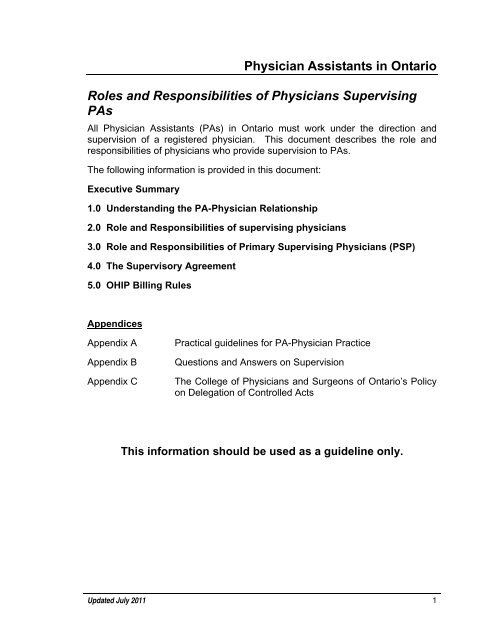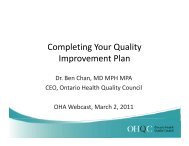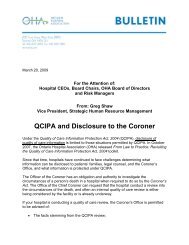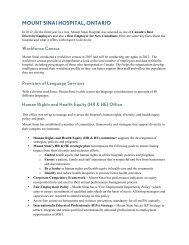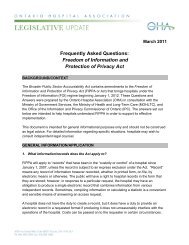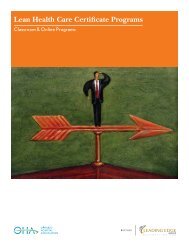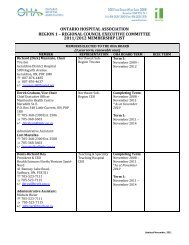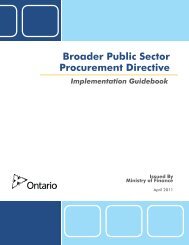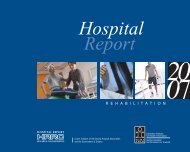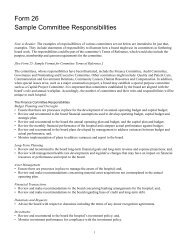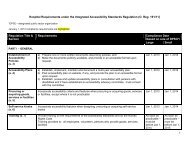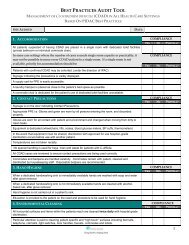Roles and Responsibilities of Physicians Supervising PAs - Ontario ...
Roles and Responsibilities of Physicians Supervising PAs - Ontario ...
Roles and Responsibilities of Physicians Supervising PAs - Ontario ...
- No tags were found...
You also want an ePaper? Increase the reach of your titles
YUMPU automatically turns print PDFs into web optimized ePapers that Google loves.
Physician Assistants in <strong>Ontario</strong><strong>Roles</strong> <strong>and</strong> <strong>Responsibilities</strong> <strong>of</strong> <strong>Physicians</strong> <strong>Supervising</strong><strong>PAs</strong>All Physician Assistants (<strong>PAs</strong>) in <strong>Ontario</strong> must work under the direction <strong>and</strong>supervision <strong>of</strong> a registered physician. This document describes the role <strong>and</strong>responsibilities <strong>of</strong> physicians who provide supervision to <strong>PAs</strong>.The following information is provided in this document:Executive Summary1.0 Underst<strong>and</strong>ing the PA-Physician Relationship2.0 Role <strong>and</strong> <strong>Responsibilities</strong> <strong>of</strong> supervising physicians3.0 Role <strong>and</strong> <strong>Responsibilities</strong> <strong>of</strong> Primary <strong>Supervising</strong> <strong>Physicians</strong> (PSP)4.0 The Supervisory Agreement5.0 OHIP Billing RulesAppendicesAppendix AAppendix BAppendix CPractical guidelines for PA-Physician PracticeQuestions <strong>and</strong> Answers on SupervisionThe College <strong>of</strong> <strong>Physicians</strong> <strong>and</strong> Surgeons <strong>of</strong> <strong>Ontario</strong>’s Policyon Delegation <strong>of</strong> Controlled ActsThis information should be used as a guideline only.Updated July 2011 1
Executive SummaryAll <strong>PAs</strong> in <strong>Ontario</strong> must work under the direction <strong>and</strong> supervision <strong>of</strong> a registeredphysician.The following are key concepts related to supervision <strong>of</strong> a Physician Assistant:• A physician is responsible <strong>and</strong> accountable for the clinical work completed bya PA. <strong>Physicians</strong> should only assign work that the physician is competent todo him or herself <strong>and</strong> that the PA is competent to perform, that is appropriateto the practice setting <strong>and</strong> that is in the patients’ best interests.• <strong>PAs</strong> have varying competencies depending on their program <strong>of</strong> preparation<strong>and</strong> experience. <strong>Supervising</strong> physicians need to assess a PA’s competenciesprior to assigning tasks. A practice agreement 1 should be established todocument the PA’s competencies, the type <strong>of</strong> clinical work <strong>and</strong> methods <strong>of</strong>delegating that will be used in that practice setting.• A PA is always under supervision <strong>of</strong> a physician who will provide direct orindirect supervision as they deem appropriate.• All PA activity takes place within an established physician-patient relationship.The supervising physician is ultimately responsible for coordinating <strong>and</strong>managing the care <strong>of</strong> the patient.• The assignment <strong>of</strong> clinical work to a PA must be in accordance with theregulatory framework in <strong>Ontario</strong>.• When the clinical work assigned to a PA involves a controlled act 2 , theprocess <strong>of</strong> delegation described in The College <strong>of</strong> <strong>Physicians</strong> <strong>and</strong>Surgeons <strong>of</strong> <strong>Ontario</strong>’s Policy on Delegation <strong>of</strong> Controlled Acts must befollowed. <strong>Physicians</strong> may use a direct order to authorize a PA to perform aspecific controlled act for a specific patient when the patient is known to thephysician. <strong>Physicians</strong> may also use a medical directive to authorize a PA toperform controlled acts under certain circumstances, <strong>and</strong> for a specifiedgroup <strong>of</strong> patients, in advance <strong>of</strong> the anticipated relationship between a patient<strong>and</strong> a physician.• It is an ongoing responsibility <strong>of</strong> both the supervising physician <strong>and</strong> the PA toensure that the clinical work assigned, the process for assigning or delegatingwork, <strong>and</strong> the supervision provided to the PA are appropriate.Communication, role clarity <strong>and</strong> mutual respect are essential for establishing12A practice agreement details the types <strong>of</strong> clinical work that the PA can perform <strong>and</strong> how thatwork will be assigned <strong>and</strong> supervised. A practice agreement is described in the Federation <strong>of</strong>Health Regulatory Colleges <strong>of</strong> <strong>Ontario</strong>’s resources on delegation.Controlled Acts are specific acts or procedures that certain types <strong>of</strong> health pr<strong>of</strong>essionals areauthorized to provide under <strong>Ontario</strong>’s Regulated Health Pr<strong>of</strong>essions Act (1991)Updated July 2011 2
<strong>and</strong> maintaining the unique working relationship between the physician <strong>and</strong>the PA.In most work settings, one physician will be the Primary <strong>Supervising</strong> Physician(PSP) for each PA. The PSP will typically have clinical responsibilities thatinclude orienting the PA, establishing the PA’s competency <strong>and</strong> the role in thatpractice setting, developing the PA practice agreement <strong>and</strong> overseeingsupervision <strong>of</strong> the PA by other physicians as appropriate. The PSP will alsotypically have administrative responsibilities, which will include overseeing <strong>PAs</strong>cheduling to ensure adequate supervision <strong>and</strong> participating in the PA’sperformance evaluation.Each PA may be supervised by multiple physicians in their clinical setting.Physician supervisors will liaise with the PSP regarding the clinical work <strong>of</strong> thePA, to ensure that they are aware <strong>of</strong> the practice agreement established in thatclinical setting. Each physician is responsible for the clinical work they personallyassign to the PA.<strong>Physicians</strong> who submit claims to OHIP may submit a claim for the clinical workthey personally perform. If the PA provides the clinical activity without the activeparticipation <strong>of</strong> the supervising physician, then a fee is not payable by OHIP tothe supervising physician. If the physician renders a service personally to thepatient, the physician is entitled to be paid for the service actually rendered bythe physician, which may or may not be the service rendered by the PA.Updated July 2011 3
1.0 Underst<strong>and</strong>ing the PA-Physician RelationshipA PA is a health care provider who “extends the h<strong>and</strong>” <strong>of</strong> a supervising physicianin a variety <strong>of</strong> health care settings. <strong>PAs</strong> support physicians as the principlemedical-decision maker. At all times, the supervising physician is responsible forthe direction <strong>of</strong> the PA’s activities <strong>and</strong> holds overall responsibility for patient care.The concepts <strong>of</strong> supervision <strong>and</strong> assignment <strong>of</strong> clinical work arefundamental to the PA-physician relationship.SupervisionA PA requires ongoing supervision by a registered physician. The physician whoassigns clinical work to a PA is responsible for ensuring adequate supervisionwhile that work is being carried out. Supervision may be direct (i.e. visualobservation <strong>of</strong> the PA when clinical work is being carried out) or indirect (i.e.direction <strong>and</strong> management <strong>of</strong> the clinical work <strong>of</strong> the PA without direct, visualobservation). At all times, the supervising physician should be available to thePA, either in person, by phone or by electronic means.The physician <strong>and</strong> the PA should determine the type <strong>of</strong> supervision (direct orindirect) that is required for the PA to effectively carry out the clinical work thathas been assigned. This decision may be dependant on many factors, including:• the characteristics <strong>of</strong> the patient being served• the predictability <strong>and</strong> risk <strong>of</strong> the procedure or task that has been assigned• the type <strong>of</strong> practice setting• the clinical skills <strong>and</strong> experience <strong>of</strong> the PA• the comfort level <strong>of</strong> the supervising physician, <strong>and</strong>• the familiarity <strong>of</strong> the organization with the PA roleThe supervising physician should then ensure that the agreed upon level <strong>of</strong>supervision is provided when the PA is performing the clinical work that has beenassigned.It should be noted that the type <strong>of</strong> supervision provided to a PA may vary overtime. It is likely that much direct supervision may be required at the start <strong>of</strong> thePA-physician relationship due to the time needed to:• establish a working relationship• assess the competencies <strong>of</strong> the PA <strong>and</strong> establish the practice agreement inthat setting• establish medical directives• adapt to <strong>and</strong> underst<strong>and</strong> this new role in the <strong>Ontario</strong> health care contextUpdated July 2011 4
Per the judgement <strong>of</strong> the supervising physician, the knowledge, skills <strong>and</strong>judgement <strong>of</strong> the PA, <strong>and</strong> pending the circumstances in a particular practicesetting, the PA may perform clinical work with less direct supervision over time.It is the responsibility <strong>of</strong> both the supervising physician <strong>and</strong> the PA to ensure thatthe type <strong>of</strong> clinical work assigned to the PA, the process used to assign clinicalwork, <strong>and</strong> the type <strong>of</strong> supervision provided while the work is being carried out isappropriate. Each PA <strong>and</strong> physician will establish a unique working relationshipwithin the parameters <strong>of</strong> this supervisory framework. Communication, role clarity<strong>and</strong> mutual respect will be essential in establishing <strong>and</strong> maintaining this workingrelationship.Assignment <strong>of</strong> Clinical WorkClinical work that is normally within the supervising physician’s scope <strong>of</strong> practicemay be assigned to a PA. Whenever clinical work is assigned to a PA, the workremains the responsibility <strong>of</strong> the physician that assigned it. Prior to assigningclinical work physicians must consider the following:• the best interest <strong>of</strong> the patient• the competence <strong>of</strong> the PA to safely complete the task• the amount <strong>of</strong> supervision the PA should have in completing the work, <strong>and</strong>how that supervision will be provided• the organization’s policies <strong>and</strong> proceduresEach PA <strong>and</strong> their supervising physician(s) should establish a practiceagreement that documents the types <strong>of</strong> clinical work the PA will perform in thatpractice setting, how that work will be assigned <strong>and</strong> the type <strong>of</strong> supervision theywill receive when performing that work. Clinical work assigned to <strong>PAs</strong> will vary,but will typically include things like:• conducting patient interviews <strong>and</strong> taking medical histories• performing physical examinations• providing counselling on preventive health care• performing certain controlled acts delegated by a physician• performing other tasks within the supervising physician’s scope <strong>of</strong> practicethat the physician deems the PA qualified to complete.Clinical work assigned to a PA may include acts that are controlled 3 under theRegulated Health Pr<strong>of</strong>essions Act (RHPA) in <strong>Ontario</strong>. While <strong>PAs</strong> are notindependently authorized to perform controlled acts under the RHPA, physicians3Controlled Acts are specific acts or procedures that certain types <strong>of</strong> health pr<strong>of</strong>essionals areauthorized to provide under <strong>Ontario</strong>’s Regulated Health Pr<strong>of</strong>essions Act (1991)Updated July 2011 5
are 4 <strong>and</strong> may choose to delegate the authority to perform these acts to a PA 5 . Inorder to do so, physicians must follow the process <strong>of</strong> delegation described in TheCollege <strong>of</strong> <strong>Physicians</strong> <strong>and</strong> Surgeons <strong>of</strong> <strong>Ontario</strong>’s Policy on Delegation <strong>of</strong>Controlled Acts 6 .CPSO’s Policy allows for controlled acts to be delegated in one <strong>of</strong> two ways:• Through a direct order. A direct order provides instructions from anindividual physician to the PA (<strong>and</strong>/or others), relating to a specific patient. Ittakes place after the physician <strong>and</strong> patient have established a relationship.The order indicates a specific procedure or treatment to be delivered at aspecific time for that patient. The direct order may be verbal (over thetelephone or in person) or written.• Through a medical directive. A medical directive is an advance instructionfrom a physician, or group <strong>of</strong> physicians, to the PA (<strong>and</strong>/or other providers). Itpertains to any patient who meets the criteria set out in the medical directive.The medical directive contains the delegation <strong>and</strong> provides the authority forthe PA to carry out the treatments, interventions or procedures that arespecified in the directive, providing that certain conditions <strong>and</strong> circumstancesexist. The directive can authorize the PA to act before the actual physicianpatientrelationship has been established. However, a relationship betweenthe patient <strong>and</strong> physician must be established before the end <strong>of</strong> thatencounter.2.0 Role <strong>and</strong> <strong>Responsibilities</strong> <strong>of</strong> the <strong>Supervising</strong> PhysicianA PA requires the direction <strong>and</strong> supervision <strong>of</strong> clinical work by a registeredphysician. Any physician who assigns <strong>and</strong> supervises the clinical work <strong>of</strong> a PAmust:• underst<strong>and</strong> the PA-physician relationship, <strong>and</strong>• be willing to work with the PA in a manner that supports the PA-physicianrelationship.In some practice settings, a PA may receive supervision from multiplephysicians. It may be that the best model for PA practice involves the PAworking with multiple physicians during one shift, multiple physicians on variousshifts, or multiple physicians over time. Some physicians may provide more456<strong>Physicians</strong> are authorized to perform 12 <strong>of</strong> the 13 controlled acts set out in the RegulatedHealth Pr<strong>of</strong>essions ActUnder appropriate circumstances, physicians may delegate the controlled acts which theyhave authority to perform to other individuals, who may or may not be members <strong>of</strong> aregulated health pr<strong>of</strong>essionThis policy is appended to this document.Updated July 2011 6
supervision to the PA than others. However, no matter what the model <strong>of</strong>supervision in that clinical setting, each supervising physician is responsible forthe clinical work that they assign to the PA.Any physician who supervises a PA will:• ensure that they assign clinical work <strong>and</strong> provide supervision to the PA in amanner that is consistent with the PA-Physician relationship <strong>and</strong> supervisoryframework• ensure that they assign clinical work <strong>and</strong> provide supervision to the PA in amanner that is consistent with the practice agreement established for the PAin that clinical setting• provide feedback on the PA’s clinical performance for purposes <strong>of</strong>competency evaluation, performance management <strong>and</strong> the development <strong>of</strong>authorizing mechanisms (e.g. medical directives)In order to fulfill these obligations, it is imperative that supervising physiciansunderst<strong>and</strong>:• the PA role, responsibilities <strong>and</strong> competencies• the framework defining the relationship between the PA <strong>and</strong> the supervisingphysician• the regulatory framework for delegation <strong>of</strong> controlled acts, including theCPSO’s Policy on Delegation <strong>of</strong> Controlled Acts• the specific competencies <strong>of</strong> the PA to whom they are assigning work, <strong>and</strong>the role established for that PA in that particular practice setting• who to go to if they have questions or concerns about working with the PA3.0 Role <strong>and</strong> <strong>Responsibilities</strong> <strong>of</strong> the Primary <strong>Supervising</strong> PhysicianNo matter how many physicians provide supervision to a PA within a practicesetting, it is considered best practice that one physician is identified as thePrimary <strong>Supervising</strong> Physician for each PA.The Primary <strong>Supervising</strong> Physician (PSP) is the physician that a PA is“assigned to” where they work. The PSP will oversee <strong>and</strong> coordinate theclinical activities <strong>of</strong> the PA, <strong>and</strong> ensure that another physician providesclinical supervision to the PA when the PSP is not able to do so. The PSPmay or may not provide the majority <strong>of</strong> clinical supervision to the PA.In addition to the responsibilities <strong>of</strong> any physician who assigns clinical work to aPA, the PSP will typically have additional clinical <strong>and</strong> administrativeresponsibilities.Updated July 2011 7
Additional clinical responsibilities <strong>of</strong> the PSP typically include:• receiving the PA at the start <strong>of</strong> the contract <strong>and</strong> ensuring that the PA isoriented to the clinical setting• coordinating activities to help integrate the PA role into the existing clinicalteam (for example, a team meeting to introduce the PA <strong>and</strong> discuss roles)• providing clinical supervision to the PA at the start <strong>of</strong> the PA’s contract, <strong>and</strong>for the duration <strong>of</strong> the probationary period• coordinating the development <strong>of</strong> the clinical practice agreement for the PA 7• coordinating the development <strong>and</strong> approval <strong>of</strong> authorizing mechanismsrequired for the PA to practice within the department (for example, medicaldirectives)• co-ordinating the clinical supervision <strong>of</strong> the PA by other physicians asappropriate. This includes determining when the PA is ready to besupervised by other physicians, <strong>and</strong> ensuring that other physicians are aware<strong>of</strong> their responsibilities as a PA supervisor.• providing ongoing supervision, oversight <strong>and</strong> coordination for the clinicalactivity <strong>of</strong> the PA for the duration <strong>of</strong> the contractAdditional administrative responsibilities <strong>of</strong> the PSP typically include:• ensuring the PA has completed any orientation, training or skills developmentnecessary for practice in that clinical setting• overseeing the scheduling <strong>of</strong> the PA’s clinical activities, ensuring thatappropriate supervision for the PA is available during all scheduled workhours• co-ordinating evaluation <strong>of</strong> the PA’s performance. This may include collectinginput from other physicians <strong>and</strong> team members for purposes <strong>of</strong> competencyevaluation, development <strong>of</strong> authorizing mechanisms, <strong>and</strong> performancemanagement.• acting as a resource for the PA <strong>and</strong> team should any clinical conflicts orquestions arise7The practice agreement documents the types <strong>of</strong> clinical work the PA will perform in thatpractice setting, <strong>and</strong> the amount <strong>and</strong> type <strong>of</strong> supervision they will receive when performingthat work. Further information on practice agreements can be found in the Delegation <strong>and</strong>Medical Directive Toolkits available through OHA, OMA <strong>and</strong> AOHC, <strong>and</strong> through theFederation <strong>of</strong> Health Regulatory Colleges <strong>of</strong> <strong>Ontario</strong>’s resources on delegation.Updated July 2011 8
5.0 OHIP Billing Rules for PA PracticeThe general rule is that physicians cannot bill for the work <strong>of</strong> Physician Assistantsunless the circumstances requires the active participation <strong>of</strong> the physician in theclinical activity <strong>of</strong> the PA. Thus,• if a supervising physician renders a service to the patient in addition to theservice rendered by the PA, then the physician may bill for the service theypersonally render.• if the clinical activity is provided without participation service being renderedby the supervising physician, then the supervising physician would not beable to bill for the service rendered by the PA.In defining participation service, the rules state that "it would be inappropriate forthe physician to submit a claim to OHIP for simply greeting the patient" -- areasonable contribution to the clinical encounter is required. The rules specifythat the physician must engage in the history, performance <strong>of</strong> any "necessary"(further) physical examination <strong>and</strong> communication <strong>of</strong> a diagnosis <strong>and</strong>/ortreatment plan.This does not mean that the physician must duplicate the service to bill for theirrole in review <strong>and</strong> oversight. In a circumstance where the PA has rendered aservice, but the physician meets with the patient, the physician may bill a partialor complete assessment or consultation if they perform the required elements <strong>of</strong>the service personally. This may be a fairly brief encounter depending on thenature <strong>of</strong> the service provided <strong>and</strong> the skills <strong>and</strong> experience <strong>of</strong> the PA. The feecode claimed must be consistent with the service performed by the physician.Updated July 2011 9
Appendix APractical Guidelines for PA – Physician Practice in <strong>Ontario</strong>The following guidelines have been adapted from the American MedicalAssociation’s Guidelines for PA-Physician Practice (adopted by the AMA House<strong>of</strong> Delegates, June 1995):1. Health care services delivered by physicians <strong>and</strong> PA must be within thescope <strong>of</strong> the supervising physician’s authorized practice.2. The supervising physician is ultimately responsible for coordinating <strong>and</strong>managing the care <strong>of</strong> patients <strong>and</strong>, with the appropriate input <strong>of</strong> the PA,ensuring the quality <strong>of</strong> health care provided to patients.3. The physician is responsible for supervising the PA (directly or indirectly)who performs health care tasks that he/she has assigned.4. The role <strong>of</strong> the PA in the delivery <strong>of</strong> care should be defined through mutuallyagreed upon guidelines that are developed by the physician <strong>and</strong> the PA.These should be documented in a practice agreement in each setting.5. The supervising physician must be available for consultation with the PA atall times either in person or through telecommunication systems or othermeans. <strong>Supervising</strong> physicians should provide direct <strong>and</strong>/or on-sitesupervision until the PA has demonstrated competency in all tasks that willbe assigned or delegated.6. The extent <strong>of</strong> the involvement by the PA in the assessment <strong>and</strong>implementation <strong>of</strong> treatment will depend on the complexity <strong>and</strong> acuity <strong>of</strong> thepatient's condition, <strong>and</strong> the training, experience <strong>and</strong> preparation <strong>of</strong> the PAas adjudged by the physician.7. Patients should be made clearly aware at all times whether they are beingcared for by a physician or a PA.8. The physician <strong>and</strong> PA together should review all assigned patient serviceson a regular basis, as well as the mutually agreed upon guidelines forpractice relating to delegated acts.9. The physician is responsible for clarifying <strong>and</strong> familiarizing the PA withhis/her supervision style.10. The primary supervising physician <strong>and</strong> the PA should clarify the roles <strong>and</strong>responsibilities <strong>of</strong> the various physician supervisors that the PA may have,as well as the administrative lead for the site. Clear expectations, lines <strong>of</strong>Updated July 2011 10
esponsibility <strong>and</strong> processes for resolving any potential conflicts should beestablished.Appendix BQuestions <strong>and</strong> Answers on SupervisionQ1. How much, <strong>and</strong> what kind <strong>of</strong>, supervision is the supervising physicianrequired to provide?<strong>Physicians</strong> supervise all clinical activity assigned to the PA at all times, however,this supervision may be direct or indirect.There are several models <strong>of</strong> supervision that may apply:Direct supervision <strong>of</strong> the PA: This occurs when the PA <strong>and</strong> supervisingphysician work side by side in the same physical location. The physician canobserve the PA while interacting with patients. This type <strong>of</strong> supervision will berequired during the initial period <strong>of</strong> all PA employment to allow for theassessment <strong>of</strong> PA competencies <strong>and</strong> development <strong>of</strong> the PA role <strong>and</strong>responsibilities in that practice setting. In this circumstance, the physician willassign clinical work to the PA verbally <strong>and</strong> sign any related orders. All delegation<strong>of</strong> Controlled Acts will be within the physician-patient relationship (i.e. the patientis known to the physician) <strong>and</strong> should be done using direct orders (either verbalor written).Mixed direct/ indirect supervision <strong>of</strong> the PA: This occurs when the PA <strong>and</strong>supervising physician usually, but not always, work side by side. Some patientcare is provided with direct supervision as above, but the PA may also seepatients without direct supervision from the physician. Through verbal or writtenorders, the PA would complete clinical work, <strong>and</strong> report back to the supervisingphysician with an assessment <strong>and</strong> plan for ongoing intervention as appropriate.The supervising physician would then provide further direction to the PA. The PAmay also perform clinical work under an approved medical directive, wherein thePA can implement treatments, interventions or procedures for a patient withoutthe physician’s direct supervision. Under certain conditions, medical directiveswill allow the PA to see a patient before the patient is known to the physician,however, a supervising physician must establish a relationship with the patientbefore the patient encounter can be completed.Indirect supervision <strong>of</strong> the PA: This occurs when the PA <strong>and</strong> the supervisingphysician do not work together in the same physical location. In this model, thesupervising physician is always available to advise the PA as required. This mayinvolve phone or electronic contact if physical supervision is not possible <strong>and</strong>requires that appropriate medical directives have been put in place. This allowsthe PA to initiate or provide treatment either within an established physician-Updated July 2011 11
patient relationship or before the anticipated physician-patient relationship hasbeen established. However, if the PA’s work involves controlled acts before aphysician-patient relationship has been established, the supervising physicianmust establish a relationship with the patient before the patient encounter can becompleted.The nature <strong>and</strong> frequency <strong>of</strong> supervision required by a PA will likely vary overtime. Depending on the PA role, there may or may not be a need to progressthrough the full continuum <strong>of</strong> supervision in each practice setting. For example, aPA working in an urgent care clinic will usually work along side the supervisingphysician, <strong>and</strong> assignment <strong>of</strong> clinical work or delegation through verbal orderswould be sufficient. However, it may be more efficient for a PA working in a wellbaby clinic to initiate an assessment on routine cases before the physician seesthe patient, <strong>and</strong> thus a medical directive would need to be in place to authorizethe controlled portions <strong>of</strong> the assessment.The supervisory requirements <strong>of</strong> the PA practicing in that setting should beconsidered when scheduling hours <strong>of</strong> work for the PA at that site, to ensure thatan appropriate level <strong>of</strong> physician supervision is available at all times.Q2. Can one physician supervise more than one PA?It is not recommended that one physician is the Primary <strong>Supervising</strong> Physicianfor more than one PA. However, there may be circumstances where onephysician works with (<strong>and</strong> thus supervises) more than one PA in a site thatemploys multiple <strong>PAs</strong>. This physician could be the Primary <strong>Supervising</strong> Physicianfor one PA, <strong>and</strong> could be a supervising physician for any number <strong>of</strong> the other<strong>PAs</strong> as appropriate.Q3. How does a supervising physician ensure that the PA’s competencyhas been established <strong>and</strong> that proper processes for the delegation <strong>of</strong>Controlled Acts have been implemented?The CPSO’s Policy on Delegation <strong>of</strong> Controlled Acts requires that, among otherthings, physicians have ensured the competency <strong>of</strong> the person to whom theydelegate. The Federation <strong>of</strong> Health Regulatory Colleges <strong>of</strong> <strong>Ontario</strong> hasdeveloped resources on delegation that will help sites, physicians <strong>and</strong> teammembers walk through the steps required to ensure that competency has beenestablished <strong>and</strong> documented, <strong>and</strong> that appropriate authorizing processes arebeing used. The <strong>Ontario</strong> Hospital Association, the <strong>Ontario</strong> Medical Association<strong>and</strong> the Association <strong>of</strong> <strong>Ontario</strong> Health Centres have all established resources ondelegation specific to <strong>PAs</strong> that will also be helpful to teams that include a PA.Q4. How should orders implemented by a PA be documented?<strong>Supervising</strong> physicians <strong>and</strong> <strong>PAs</strong> will need to ensure that they are complying withCPSO guidelines <strong>and</strong> other legislative <strong>and</strong> organizational guidelines fordocumentation.Updated July 2011 12
Typically, any order, requisition or prescription implemented by the PA under adirect order will require the physician’s signature. Orders, requisitions orprescriptions implemented by the PA under a medical directive will not requirethe physician’s signature, as the physician will have signed the directive.In order to signify to those needing to act on an order or prescription that the PAhas been properly authorized to implement that order, any order or prescriptionimplemented by a PA pursuant to a medical directive should specifically identify:• The medical directive (name <strong>and</strong> number)• The PA responsible for implementing the directive (name, signature,designation <strong>and</strong> contact information)• The name <strong>and</strong> contact information <strong>of</strong> the authorizing physician.Updated July 2011 13
Appendix CThe College <strong>of</strong> <strong>Physicians</strong> <strong>and</strong> Surgeons <strong>of</strong> <strong>Ontario</strong>’s Policy onDelegation <strong>of</strong> Controlled ActsThis section is provided for reference. It presents the CPSO Guidelines onDelegation as they appear on the CPSO web site.Delegation <strong>of</strong> Controlled Acts Policy #4-03Approved by Council: September 1999Reviewed <strong>and</strong> Updated: November 2003, November 2004, February 2007Publication Date: March/April 2004To be Reviewed by: November 2008Key Words: Delegation, Controlled acts, Medical directivesRelated Topics: Medical DirectivesLegislative References: Regulated Health Pr<strong>of</strong>essions Act, 1991, sections 27, 28,29, 30, Ambulance Act Regulations, section 1College Contact: Physician Advisory ServicePurposeUnder <strong>Ontario</strong> law, certain acts (more fully described below) may only be performed by certainhealth care pr<strong>of</strong>essionals. However, under appropriate circumstances, these acts may be delegatedto others. The purpose <strong>of</strong> this policy is to assist physicians to underst<strong>and</strong> when <strong>and</strong> how they maydelegate controlled acts. Since delegation sometimes takes place by way <strong>of</strong> a medical directive, thepolicy also <strong>of</strong>fers guidelines for the use <strong>of</strong> medical directives.ScopeThis policy applies to all physicians, regardless <strong>of</strong> practice setting or type.Controlled ActsThe Regulated Health Pr<strong>of</strong>essions Act, which has governed the medical pr<strong>of</strong>ession since 1993,sets out a number <strong>of</strong> "controlled acts" which may only be performed by certain <strong>of</strong> the regulatedhealth pr<strong>of</strong>essionals. Of the 13 controlled acts, physicians are entitled to perform 12 <strong>and</strong> may, inappropriate circumstances, delegate the performance <strong>of</strong> those acts to other individuals who may ormay not be members <strong>of</strong> a regulated health pr<strong>of</strong>ession.The controlled acts set out in the Regulated Health Pr<strong>of</strong>essions Act (RHPA) are:Updated July 2011 14
1. Communicating to the individual or his or her personal representative a diagnosis identifying adisease or disorder as the cause <strong>of</strong> the symptoms <strong>of</strong> the individual in circumstances in which itis reasonably foreseeable that the individual or his or her personal representative will rely onthe diagnosis.2. Performing a procedure on tissue below the dermis, below the surface <strong>of</strong> a mucous membrane,in or below the surface <strong>of</strong> the cornea, or in or below the surfaces <strong>of</strong> the teeth, including thescaling <strong>of</strong> teeth.3. Setting or casting a fracture <strong>of</strong> a bone or a dislocation <strong>of</strong> a joint.4. Moving the joints <strong>of</strong> the spine beyond the individual's usual physiological range <strong>of</strong> motion usinga fast, low amplitude thrust.5. Administering a substance by injection or inhalation.6. Putting an instrument, h<strong>and</strong> or finger,i. beyond the external ear canal,ii.iii.iv.beyond the point in the nasal passages where they normally narrow,beyond the larynx,beyond the opening <strong>of</strong> the urethra,v. beyond the labia majora,vi.vii.beyond the anal verge,or into an artificial opening in the body.7. Applying or ordering the application <strong>of</strong> a form <strong>of</strong> energy prescribed by the regulations under theRHPA.8. Prescribing, dispensing, selling or compounding a drug as defined in clause 117(1) <strong>of</strong> the Drug<strong>and</strong> Pharmacies Regulation Act, or supervising the part <strong>of</strong> a pharmacy where such drugs arekept.9. Prescribing or dispensing, for vision or eye problems, subnormal vision devices, contact lensesor eye glasses other than simple magnifiers.10. Prescribing a hearing aid for a hearing impaired person.11. Fitting or dispensing a dental prosthesis, orthodontic or periodontal appliance or device usedinside the mouth to prevent the teeth from abnormal functioning. 112. Managing labour or conducting the delivery <strong>of</strong> a baby.13. Allergy challenge testing <strong>of</strong> a kind in which a positive result <strong>of</strong> the test is a significant allergicresponse.Emergency SituationsUpdated July 2011 15
Although the RHPA prohibits performance <strong>of</strong> controlled acts by those not specifically authorized toperform them, it does not apply if the person performing the act is doing so to render first aid ortemporary assistance in an emergency. 2 For example, if a passer-by sees someone in cardiacarrest in an airport <strong>and</strong> uses an automatic external defibrillator to assist him or her, there is nobreach <strong>of</strong> the RHPA. Although applying a form <strong>of</strong> energy prescribed in the regulations is acontrolled act under the RHPA, when it is done in an emergency it is not prohibited.Principles <strong>of</strong> DelegationThe vision <strong>of</strong> the College is to ensure the best quality care for the people <strong>of</strong> <strong>Ontario</strong> by the doctors<strong>of</strong> <strong>Ontario</strong>. In order to most effectively meet patient needs, health care is <strong>of</strong>ten delivered bymultidisciplinary teams. When controlled acts are delegated in appropriate circumstances, thisprocess can result in more timely delivery <strong>of</strong> quality health care, <strong>and</strong> can make optimal use <strong>of</strong>health-care resources <strong>and</strong> personnel. In every instance <strong>of</strong> delegation, the primary considerationshould be the best interests <strong>of</strong> the patient. Responsibility for the delegation <strong>of</strong> the controlled actalways remains with the delegating physician.Delegation may take place in one <strong>of</strong> two ways:1. Direct OrdersThe direct order provides instructions from an individual physician to another health care provider ora group <strong>of</strong> health care providers. The order relates to only one patient <strong>and</strong> initiates a specificintervention or treatment to be delivered at a specific time. It may be verbal 3 (over the telephone orin person) or written. 4 A direct order always takes place after a physician-patient relationship hasbeen established. 52. Medical DirectivesMedical directives are blanket instructions by physicians (<strong>of</strong>ten more than one) to other health careproviders. They pertain to any patient who meets the criteria set out in the medical directive. Themedical directive contains the delegation <strong>and</strong> provides the authority to carry out the treatments,interventions or procedures that are specified in the directive, providing that certain conditions <strong>and</strong>circumstances exist. 6 In most cases, medical directives are used to ensure that health care can bedelivered without a physician’s direct assessment <strong>of</strong> the patient or direct supervision. Their use isespecially frequent in institutional settings. 7A medical directive must always be written <strong>and</strong> must comply with the principles set out in thispolicy. Guidelines about the use <strong>and</strong> development <strong>of</strong> medical directives are found in Appendix 1 tothis policy. A prototype <strong>of</strong> a medical directive can be found at Appendix 2.A more comprehensive guide <strong>and</strong> toolkit is posted on the Federation <strong>of</strong> Health Regulatory College<strong>of</strong> <strong>Ontario</strong>’s (FHRCO) website at http://www.medicaldirectives-delegation.com. This guide wasdeveloped by a working group <strong>of</strong> FHRCO in 2006.The toolkit provides templates for construction <strong>of</strong> Medical Directives, as well as explanations <strong>of</strong> howto establish the prerequisites. The templates will have the most direct application for largeinstitutional settings, but anyone who wishes to establish a Directive (or to learn more aboutdelegation) will find them helpful. Their use is not m<strong>and</strong>atory, but any physician who delegates acontrolled act pursuant to a Medical Directive developed using these templates will be incompliance with the legislation <strong>and</strong> College policy <strong>and</strong> will be providing the very best quality <strong>of</strong> careto patients.Guidelines for DelegationUpdated July 2011 16
1. Physician-Patient RelationshipThe overriding principle <strong>of</strong> delegation is that it must usually occur in the context <strong>of</strong> a physicianpatientrelationship. In all instances where a controlled act is delegated, the act remains theresponsibility <strong>of</strong> the physician who authorized it. In most cases, delegation will only occur after thephysician has interviewed the patient, performed an assessment, made recommendations,obtained an informed consent to proceed, <strong>and</strong> instituted a course <strong>of</strong> therapy.In some instances, the patient’s interests will best be served by having the performance <strong>of</strong> thecontrolled act take place prior to assessment by the physician: in a hospital emergency room, forexample, where it is commonplace for some tests to be ordered by a nurse before a physician hasseen the patient. In such circumstances, the delegation may take place pursuant to a physician’sdirect order (where the physician has previously met the patient or engages in a consultation withthe health care pr<strong>of</strong>essional who will perform the delegated act) or a medical directive. 8 When thishappens, it is expected that a physician under whose authority the controlled act has beenperformed will meet <strong>and</strong> assess the patient as soon after it has been performed as possible.The use <strong>of</strong> medical directives to authorize performance <strong>of</strong> a controlled act in advance <strong>of</strong>establishing a physician-patient relationship is intended to capture only those situations where it isin the patient’s best interests to do so. It is not intended to capture situations where, for pecuniaryor convenience reasons, a physician wishes to delegate a controlled act (for example, thedelegation <strong>of</strong> Botox injections in the absence <strong>of</strong> a contemporaneous face to face assessment wouldnot be endorsed by the College).In very limited circumstances delegation may occur in the absence <strong>of</strong> a doctor-patient relationship.One example is the provision <strong>of</strong> care by paramedics under the direct control <strong>of</strong> base hospitalphysicians. 9 Another example is in remote <strong>and</strong> isolated regions <strong>of</strong> the province where primary careis administered by registered nurses acting in exp<strong>and</strong>ed roles. Such programs have establishedprotocols <strong>and</strong> quality assurance mechanisms that provide a proper basis upon which delegationmay occur with good public protection even without a traditional physician-patient relationship.2. Delegate only those acts that form part <strong>of</strong> your regular practice.The RHPA requires the physician to confine medical practice to those areas <strong>of</strong> medicine in whichhe or she is suitably trained <strong>and</strong> experienced. A physician must not delegate the performance <strong>of</strong> anact he or she is not competent to perform personally, <strong>and</strong> which does not form part <strong>of</strong> his or herregular practice <strong>and</strong> daily competency.3. Identify the individual performing the act <strong>and</strong> be aware <strong>of</strong> his or her skills.i) Ensure the individual receiving the delegation has the appropriate knowledge, skill <strong>and</strong>judgement to perform the delegated act.The physician should be satisfied that the individual to whom the act is being delegated has theappropriate knowledge, skill <strong>and</strong> judgement to perform the delegated act. A physician must notdelegate an act where there is a question as to the knowledge, skill <strong>and</strong> judgement <strong>of</strong> the delegate.The College recognizes that in some cases the physician may not personally know the individual towhom he or she is delegating. For example, in a public hospital setting, the hospital employs thedelegates (nurses, respiratory technicians, etc.) <strong>and</strong> the medical staff are not involved in the hiringprocess. In this case, it is the institution's responsibility to ensure that its employees have therequisite knowledge, skill <strong>and</strong> judgement.ii) Check with the relevant regulatory body <strong>of</strong> other health pr<strong>of</strong>essionals where applicable.Updated July 2011 17
Before delegating performance <strong>of</strong> any aspect <strong>of</strong> delivery <strong>of</strong> health care, the physician should firstdetermine whether it is a controlled act. Where the individual to whom the act is being delegated isa member <strong>of</strong> a regulated health pr<strong>of</strong>ession, the physician should ensure the delegation conforms tothe regulations, policies <strong>and</strong>/or guidelines <strong>of</strong> that health pr<strong>of</strong>ession. If it does not, the delegate willnot be able to carry out the delegation. Where the physician knows that the delegate is notpermitted to perform the controlled act, the physician must not delegate the act.Because quality care is the primary concern physicians must not delegate the performance <strong>of</strong> acontrolled act to a person whose certificate to practise any health pr<strong>of</strong>ession is revoked orsuspended by the governing body <strong>of</strong> his or her discipline at the time <strong>of</strong> the delegation.Delegation <strong>of</strong> acts which are not controlled are not subject to concerns about regulations, policies<strong>and</strong>/or guidelines <strong>of</strong> other health pr<strong>of</strong>essions. However, it would be inappropriate to delegate anyact to a person whose certificate to practise has been revoked or suspended.4. Establish a process for delegation, or ensure that there is one in place, that includeseducation, ensuring the maintenance <strong>of</strong> competence in the performance <strong>of</strong> the delegatedact, <strong>and</strong> providing the appropriate supports.i) The physician should satisfy him or herself that the delegation is in the best interests <strong>of</strong>the patient.Patient care must not be compromised by the delegation.ii) Identify the risk involved in delegating the act.The physician must analyse the potential harm associated with the performance <strong>of</strong> the delegatedact <strong>and</strong> be satisfied that delegating the act does not increase the risk to the patient. Someprocedures in some circumstances carry such a high risk that only a physician should performthem. In such instances, the physician must not delegate.iii) Quality assuranceIf the particular act is routinely delegated (for example, in a hospital pursuant to a medical directiveor in an <strong>of</strong>fice setting where staff roles include performance <strong>of</strong> medical acts), the physician mustensure there is ongoing monitoring <strong>and</strong> evaluation <strong>of</strong> the delegation. This would include ensuringthe currency <strong>of</strong> the delegate’s knowledge <strong>and</strong> skills <strong>and</strong> that there is an objective <strong>and</strong> regularlyscheduled assessment <strong>of</strong> those skills. It would also include evaluating the delegation process itselfto ensure that the process is safe <strong>and</strong> effective. 10iv) Ensure appropriate resources <strong>and</strong> equipment are available.As part <strong>of</strong> the risk analysis undertaken to determine whether the act can be appropriatelydelegated, the physician will identify certain resources or equipment as necessary to reduce risk.The physician must ensure that such resources <strong>and</strong> equipment are available on site where thedelegated procedure is being performed.v) Develop written documentation about the delegation process.The physician should ensure that there is appropriate documentation <strong>of</strong> all steps taken to meet theabove guidelines. This documentation would be a key resource in answering any concerns orquestions about the delegation process.5. Ensure delegation occurs with the informed consent <strong>of</strong> the patient where feasible.Updated July 2011 18
In instances where there is an established physician-patient relationship, physicians must ensurethat patients provide informed consent 11 for performance <strong>of</strong> the act by a delegate, rather than thephysician. In circumstances where the delegation takes place pursuant to a medical directive, theprotocol for the directive must include obtaining the appropriate patient consent.The patient's consent must be documented on the medical record.6. Ensure proper supervision <strong>of</strong> the delegation.It is important to remember that the accountability <strong>and</strong> responsibility for the act that has beendelegated remain with the delegating physician. A physician delegating a controlled act mustprovide the appropriate level <strong>of</strong> supervision to ensure that the act is performed properly <strong>and</strong> safely.The nature <strong>of</strong> the supervision will vary according to the assessment <strong>of</strong> risk, taking into account thespecific act being delegated, the circumstances under which the act will be performed <strong>and</strong> thequalifications <strong>and</strong> experience <strong>of</strong> the person performing it.7. Consider any liability issues that may arise from delegation.The physician might wish to be aware <strong>of</strong> whether or not the person to whom the controlled act isbeing delegated is appropriately covered by insurance or otherwise in a position to meet any liabilitywhich may arise from the performance <strong>of</strong> the delegated act. The Canadian Medical ProtectiveAssociation can provide advice about a physician’s own liability.8. Consider any billing issues that may arise from delegation.<strong>Physicians</strong> should be aware that the Schedule <strong>of</strong> Benefits <strong>of</strong> the <strong>Ontario</strong> Health Insurance Plan(OHIP) contains particular provisions as to the circumstances under which remuneration can beclaimed from OHIP by physicians for the performance <strong>of</strong> acts that have been delegated to others.The Schedule <strong>of</strong> Benefits also indicates that applications for exceptions to these rules may bemade upon the recommendation <strong>of</strong> the <strong>Ontario</strong> Medical Association (OMA) <strong>and</strong> the College.<strong>Physicians</strong> who bill OHIP <strong>and</strong> who are considering delegating performance <strong>of</strong> controlled acts toothers should carefully review the provisions <strong>of</strong> the Schedule <strong>of</strong> Benefits. The OMA <strong>and</strong> theProvider Services Branch at OHIP are available to answer questions <strong>and</strong> give advice about suchmatters. Any request to have a procedure considered for exemption from the general requirementsshould be submitted directly to the Ministry <strong>of</strong> Health <strong>and</strong> Long-Term Care (MOHLTC). The Collegewill respond to consultation requests from the MOHLTC only.Exceptions for Programs Under Medical Officer <strong>of</strong> HealthIn extremely limited circumstances, a controlled act may be delegated in the absence <strong>of</strong> a physicianorder <strong>and</strong> in the absence <strong>of</strong> the doctor-patient relationship. One example <strong>of</strong> such a circumstance iswithin programs operated under the authority <strong>of</strong> a Medical Officer <strong>of</strong> Health, such as influenzainoculation programs. In this example, the best interests <strong>of</strong> the patient is protected as long as theprogram operator adheres to the quality assurance protocols established by a Medical Officer <strong>of</strong>Health.__________________________________________________________________Appendix 1Developing a Medical DirectiveIn many instances, medical directives are created by committees or groups <strong>of</strong> physicians who willultimately sign <strong>and</strong> rely on the directive. 12 Whether the directive is developed personally by thephysician who signs it <strong>and</strong> under whose authority it is used, or whether it is developed by hospitaladministration, any physician who signs a medical directive is ultimately responsible for a patientUpdated July 2011 19
who receives care pursuant to the medical directive. It is important to remember that theaccountability <strong>and</strong> responsibility for the directive <strong>and</strong> for the delegation <strong>of</strong> any controlled acts itcontains remain with the signing physician.When developing the directive, consider each <strong>of</strong> the following issues <strong>and</strong> ensure that thisconsideration is reflected in the document:1. Assess the risk.a. What is the procedure, treatment or intervention being ordered?b. How predictable are the outcomes?c. Does safe management <strong>of</strong> the possible outcomes require physician involvement orintervention?d. Are the appropriate resources available to intervene as required?e. Will delegation <strong>of</strong> the controlled act (if any) increase the risk to patients?If the risk assessment results in the conclusion that patients’ best interests would not becompromised by a medical directive, the following considerations should be taken into account.2. Consider who should be involved in the development <strong>of</strong> a medical directive.Although the directive is, strictly speaking, a physician’s order, it has a significant impact on anumber <strong>of</strong> other health care pr<strong>of</strong>essionals who will be involved in the patient’s care. Accordingly,the development <strong>of</strong> medical directives should be undertaken with a collaborative team approach. All<strong>of</strong> the health care pr<strong>of</strong>essionals who may be affected by the medical directive should be involved inits development.3. Determine the qualifications, skills or knowledge required to carry out the directive.4. Ensure that the directive addresses the requirements <strong>of</strong> Consent to Medical Treatment. 13A medical directive cannot be implemented until the patient has provided informed consent (whichmay be in writing or verbal). In a medical directive, a physician proposes that a specific treatment(i.e., an x-ray) be performed for a range <strong>of</strong> patients who meet certain conditions. Instituting amedical directive raises the possibility that a physician may not be available to obtain the patient’sinformed consent to the proposed treatment. Under these circumstances, the physician is alsoassigning to another person the responsibility for obtaining the patient’s informed consent for theproposed treatment, intervention or procedure. Obtaining informed consent includes the provision<strong>of</strong> information <strong>and</strong> the ability to answer questions about the material risks <strong>and</strong> benefits <strong>of</strong> theprocedure, treatment or intervention proposed. If the individual who will be enacting the medicaldirective is unable to provide the information that a reasonable person would want to know in thecircumstances, the implementation <strong>of</strong> the medical directive is inappropriate.5. Consider who will sign the directive.The overriding principle <strong>of</strong> delegation is that it must occur in the context <strong>of</strong> a physician-patientrelationship. Accordingly, a physician who is ultimately responsible for the patient’s care must signthe medical directive. At least one <strong>of</strong> the signatories to the medical directive must be available (onsite or by phone) at the time it is implemented in case clarification or further intervention is required.In some hospitals medical directives are created <strong>and</strong> approved by Committees <strong>and</strong> signed only byChiefs <strong>of</strong> departments or divisions. In the College’s view this arrangement is unlikely to meet therequirement that the physician signing the medical directive must have a physician-patientUpdated July 2011 20
elationship with the patient treated pursuant to the directive. Each physician responsible for thecare <strong>of</strong> a patient who will receive the proposed treatment, intervention or procedure should sign themedical directive.Medical directives must be updated each time there is a medical staff change within the departmentor division to which the directive applies. 146. Ensure that the directive will be practically applicable <strong>and</strong> that a copy <strong>of</strong> it will beavailable to those implementing it.For instance, in an emergency department <strong>of</strong> a hospital, unless all physicians in the department aresignatories to the directive, it will be administratively difficult to institute. Hospital staff should not beexpected to determine whether the physician on call is or is not a signatory to a particular medicaldirective. If administrative simplicity is not possible, it is likely that the risk <strong>of</strong> relying on the medicaldirective is too high to justify its use.7. Consider the communication path that will enable the individual implementing adirective to identify the physician responsible for the care <strong>of</strong> the patient to be able tocontact him or her immediately if necessary.8. Consider what documentation will be required when the directive is implemented.The patient’s record should reflect what actions were taken <strong>and</strong> that the actions were pursuant to amedical directive. It may be appropriate to place a copy <strong>of</strong> the directive in the patient’s chart.9. Consider tracking/monitoring methods to identify when medical directives are beingimplemented inappropriately or are resulting in unanticipated outcomes.Contents <strong>of</strong> Medical DirectivesThe following information must always be included in a medical directive:1. The name <strong>and</strong> a description <strong>of</strong> the procedure, treatment or intervention being ordered;2. An itemized <strong>and</strong> detailed list <strong>of</strong> the specific clinical conditions that the patient must meet beforethe directive can be implemented;3. An itemized <strong>and</strong> detailed list <strong>of</strong> any situational circumstances that must exist before thedirective can be implemented;4. A comprehensive list <strong>of</strong> contraindications to implementation <strong>of</strong> the directive;5. Identification <strong>of</strong> the individuals authorized to implement the directive;6. The name <strong>and</strong> signature <strong>of</strong> the physician(s) authorizing <strong>and</strong> responsible for the directive <strong>and</strong>the date it becomes effective; <strong>and</strong>7. A list <strong>of</strong> the administrative approvals that were provided to the directive. The dates <strong>and</strong> eachCommittee (if any) should be specifically listed.A more comprehensive guide <strong>and</strong> toolkit is posted on the Federation <strong>of</strong> Health Regulatory College<strong>of</strong> <strong>Ontario</strong>’s (FHRCO) website at http://www.medicaldirectives-delegation.com. This guide wasdeveloped by a working group <strong>of</strong> FHRCO in 2006.Appendix 2 - Medical Directive PrototypeUpdated July 2011 21
MEDICAL DIRECTIVEManagement <strong>of</strong> Possible Ectopic PregnancyBackground: This section may contain a description <strong>of</strong> why the medical directive has been created<strong>and</strong>/or how it best serves the patients’ interests.Authorizing Physician(s): all individual names <strong>of</strong> ER physicians should be listedTo:Emergency Room NursesMedical Radiation TechnologistsClinical Conditions Required:Female patientsChildbearing yearsAmenorrheaVaginal “spotting”Abdominal/pelvic painSituational Conditions Required:ConsentContraindications: Patient’s vital signs must be stable. If they are, the following apply.Draw haemoglobin, blood for possible grouping <strong>and</strong> matching. B-HCG;If vital signs are abnormal, hold patient until assessed by E.R. physician; If vital signs are normal, send patient to Diagnostic Imaging, accompanied by RHA, forultrasound <strong>of</strong> pelvis.Physician’s Order:Complete blood count <strong>and</strong> differential.Serum B HCG.Pelvic ultrasound.Approvals:Emergency Department Committee - July/03Medical Advisory Committee - July/03Signatures:All ER physicians (ensure dated once signed).1. This is the only controlled act that physicians are not authorized to perform.Updated July 2011 22
2. RHPA, section 29(1)(a)3. Verbal orders should be noted in the patient’s chart by the recipient <strong>of</strong> the order <strong>and</strong> must berenewed or confirmed in accordance with the policy <strong>of</strong> the institution in which they are used.4. The order may rely on a protocol established by the physician or institution that describes thesteps to be taken in delivering treatment. A protocol is a generic set <strong>of</strong> instructions about aspecific health care scenario. The protocol itself is generic, but it is only used for a patient whenit is called for by a direct order.5. Orders given to paramedics by designated base hospital physicians are an exception to thisexpectation.6. Not all medical directives contain delegation <strong>of</strong> controlled acts. Depending on thecircumstances, medical orders may be required for controlled acts within the domain <strong>of</strong> thehealth care pr<strong>of</strong>essional receiving the delegation. In such situations, the medical directivecontains the order to perform the controlled act, but does not delegate it.7. While it is not impossible to use a medical directive in a non-institutional setting, the Collegeexpects this would rarely arise. A medical directive should be used only when it is in thepatient’s best interests to do so. It is a fundamental principle <strong>of</strong> the practice <strong>of</strong> medicine that thepatient’s interests must come first. Where a medical directive is created primarily in order toserve the physician’s best interests, the College would consider it inappropriate whether or notit actually jeopardized the patient’s wellbeing.8. A medical directive is a prescription for a drug, treatment, procedure or intervention that may beperformed for a range <strong>of</strong> patients when specific conditions <strong>and</strong> circumstances exist. See belowfor further details.9. This exception to the general principal that a doctor-patient relationship is required isestablished by the Regulations to the Ambulance Act. That legislation defines the termparamedic <strong>and</strong> stipulates that paramedics must be authorized by the medical director <strong>of</strong> a basehospital program to perform controlled acts.10. As with the requirement to identify the individual receiving the delegation, the Collegerecognizes that in some cases, usually in hospital settings, the physician will not bear theresponsibility for the quality assurance <strong>of</strong> staff. In these circumstances, the physician will meetthe College’s expectations if he or she satisfies him or herself that an appropriate qualityassurance process is in place in the institution.11. See Consent to Medical Treatment Policy for detail.12. This is not always the case – the same principles apply to private practice settings.13. See the Consent to Medical Treatment Policy.14. Where it is impractical for a hospital to have all new staff <strong>and</strong> locums sign a copy <strong>of</strong> eachmedical directive, it is acceptable if these individuals receive copies <strong>of</strong> each directive <strong>and</strong> signone statement indicating that they have read <strong>and</strong> agreed with them.15. See the Medical Records Policy.16. The individuals need not be named but may be described by qualification or position in theworkplace.16. The individuals need not be named but may be described by qualification or position in theworkplace.Updated July 2011 23


